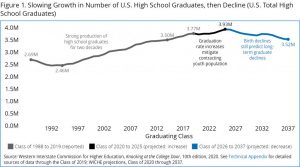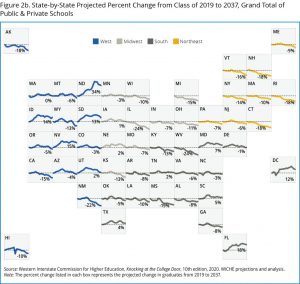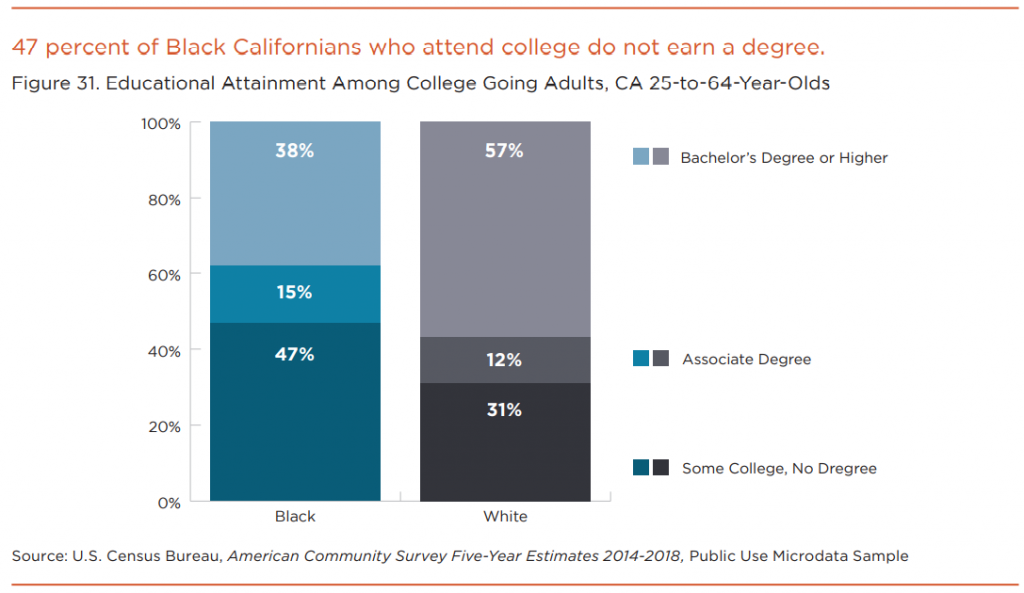Passport Review Board Annual Meeting Convened Virtually on February 11th!
The Interstate Passport Review Board (PRB) convened virtually for its Annual Meeting on Thursday, February 11, 2021. Co-chaired by Paul Disney of Western Oregon University and Kari Brown-Herbst of Laramie County Community College, the board membership includes 16 representatives from Interstate Passport member states, as well as three non-voting affiliate members and two at-large members. Attendance at the meeting was 35 people, which included committee chairs, consultants and staff.
The Board received reports from Interstate Passport staff on a number of items and activities:
- Annual report and budget;
- Significant increase in the number of members (28) during the last 12 months, which brings the membership total to 59 in 17 states;
- Call to Action to improve transfer, issued last July, generated support from nearly 200 individuals, organizations and associations;
- Award of the ECMC Foundation grant to support 20 new Network members, including 10 with Minority Student status;
- Participation in National Student Transfer Week, sponsored by the National Institute for the Study of Transfer Students;
- Numerous presentations by Passport staff and representatives throughout the year.
The Board discussed several items including but not limited to the review of 2019-2020 academic data reported by member institutions; the review and approval of policy documents; proposed revisions to the Memorandum of Agreement and Bylaws; future funding and membership growth opportunities, and election of co-chairs. Paul Disney will continue as co-chair of the PRB, representing four-year institutions. Kari Brown-Herbst will continue as the two-year representative.
The Board had a successful virtual meeting and is looking forward to meeting in person in 2022!
Data from the 2019-2020 Academic Year Continue to Suggest Passport Students Do Well!
The 2019-2020 Academic Tracking Report was presented to the Passport Review Board during their annual meeting on February 11, 2021 by author Michael Torrens, director of analysis, assessment and accreditation at Utah State University. Passports have been awarded to students since 2016; the total number awarded to date is 49,069 (see table below).
Total Number of Passports Awarded by Academic Year

Grade Point Average. Students who earned a Passport and transferred to another Network member institution earned an aggregated grade point average (GPA) of 3.54, statistically higher than the 2.92 aggregated GPA of students who transferred without a Passport in the same period (see Figure 1). In addition, academic performance GPA of students who transferred with a Passport was roughly comparable to Passport earners who remained at the same institution.

Earned Credit Hours. Students who transferred with a Passport to another Network member institution and completed two terms in AY 2019-2020 earned 13.64 student credit hours (SCH) on average, compared to 9.74 for students who transferred without a Passport (see Figure 2).

The detailed report can be found in the Interstate Passport 2019-20 Annual Report.
Interstate Passport Presentation to NASPA, February 18
 Interstate Passport staff and representatives presented a live briefing on the initiative to the NASPA – Student Affairs Administrators in Higher Education on February 18. Interstate Passport: Streamlining Transfer for Increased Student Success, featured Anna Galas, director of academic leadership initiatives at WICHE; Michael Torrens, director of analysis, assessment and accreditation at Utah State University; and Sherry Simkins, division chair, Communications and Fine Arts at North Idaho College.
Interstate Passport staff and representatives presented a live briefing on the initiative to the NASPA – Student Affairs Administrators in Higher Education on February 18. Interstate Passport: Streamlining Transfer for Increased Student Success, featured Anna Galas, director of academic leadership initiatives at WICHE; Michael Torrens, director of analysis, assessment and accreditation at Utah State University; and Sherry Simkins, division chair, Communications and Fine Arts at North Idaho College.
Galas shared information on the background and structure of the Passport and how it prevents credit loss for all students and institutions, as well as the current focus on transfer – and solutions like the Passport – due to the COVID-19 pandemic. Torrens discussed the data analysis conducted each year that tracks the progress of Passport earners to demonstrate their success. And, as North Idaho College recently became a member of the Interstate Passport Network, Simkins shared information on that process and the requirements for joining the Network.
Details about the webinar are available here.
Recent Projections Suggest the Number of High School Graduates Will Soon Decline. What Does This Mean for Enrollment Management and Transfer Students?
The Western Interstate Commission for Higher Education has recently released the 10th edition of Knocking at the College Door: Projections of U.S. High School Graduate Numbers Through 2037. Interstate Passport’s Sarah Leibrandt, program manager, interviewed two of the report’s authors, Colleen Falkenstern and Peace Bransberger, to learn more about the findings in the recent publication of Knocking at the College Door and what the implications of the projections mean for college enrollment and the importance of recruiting and supporting transfer students.
Sarah Leibrandt: Thank you very much for joining me today. I’d like to start by asking you, what is ‘Knocking at the College Door’?
Colleen Falkenstern: Knocking at the College Door: Projections of High School Graduates has been published every four years for nearly 40 years by the Western Interstate Commission for Higher Education (WICHE).This report provides detailed projections on high school graduate populations for all 50 states, the District of Columbia, and selected U.S. territories and outlying areas, and includes details about the race/ethnicity of public-school graduates, and the number of private school graduates. Data was collected and analyzed from each individual state. The most recent edition includes actual high school graduate counts through the class of 2019 and then projections through the class of 2037.

These projections are used widely across a wide range of education stakeholders from policymakers to enrollment managers at the institutional level for short- and long-term planning in terms of capacity building and understanding who their future high school graduates are on college campuses.
Sarah Leibrandt: What trends can be found in the December 2020 edition of ‘Knocking at the College Door’?
Peace Bransberger: From the national perspective, the class of 2019 includes 3.8 million high school graduates. If recent patterns persist, the number of high school graduates could peak at 4 million by 2025. After 2025, the predictions suggest a decrease in the number of high school graduates (because of the decrease of one percent of babies born every year since the great recession). So, by the class of 2037, there could be 3.5 million high school graduates (or 11 percent fewer).
Colleen Falkenstern: There are variations across and within the regions in the U.S. For example, the Midwest and Northeast will both see declines in high school graduates. These regions are less diverse as it is; while they will see increases in high school graduates from nonwhite backgrounds, that will not be enough to offset the decline in white high school graduates. The trends look strikingly different here than in the south or west.
Peace Bransberger: The South is a growth region, and with several large states, is driving the national trend. The trend in the West, which contributes 24 percent of nation’s high school graduates, roughly mirrors the national trend but it varies by state. For example, two-thirds of the western states are expected to have 5-12 percent more graduates by peak and then rapidly lose graduates by as much as 22 percent fewer in New Mexico and 3 percent fewer in Colorado. Yet, other states in the West are on a trend to have more high school graduates than the national peak in 2025.

Knocking at the College Door allows us to look at the changing demographics in high school graduates through 2037. For example, there is a significant, new pattern emerging in the West in terms of demographics: there is an increasing number of Black public high school graduates (Washington, Arizona, and Nevada will see an increase of 42 percent or more). The Western states could also see a 24 percent increase in the number of Hispanic high school graduates in the next five years than they do now.
Sarah Leibrandt: What implications might these projections and changing demographics have for college enrollment?
Colleen Falkenstern: All colleges should consider the changing demographics of high school graduates. There are differences in the overall number of projected high school graduates across the country and there will be some institutions that will see significant drops in the number of students they have historically recruited for enrollment.
Peace Bransberger: Right, it is important for institutions to rethink where their “traditional” high school students are going to be available. While some states will not experience a decline in high school graduates, there will be a decreasing number of traditional-aged college students after 2025. But this does not mean students won’t be available. It is just that they might not be the ones your institution looked at before or served before, but there are large pockets of growth in each high school graduating class.
Sarah: Given this information, how might institutions (re)consider a focus on recruiting transfer students to increase enrollment?
Colleen Falkenstern: There is a lot of data in Knocking at the College Door. And it is easy to talk about the changing numbers and trendlines in the report from a clinical perspective. One of the values of Knocking is that it can help institutions think about what student services are needed now and in five years and in ten years, to ensure that the changing demographic of college students are well served. Behind all of these projections and trend lines are students with educational goals, and if transfer is part of their pathway to their career, it is important that institutions’ services are equipped to serve this changing population of high school graduates. It’s important that institutions are meeting the needs of their students.
Peace Bransberger: As regards to transfer, some populations of students, particularly students of color, are more likely to enroll in a two-year institution first. As I mentioned earlier, some regions will see an increase among high school graduates of color and a decrease among white students. Based on historic patterns of where students have enrolled, it is likely community colleges will see an increase in enrollment, particularly among students of color.
Transfer shouldn’t be seen as a way to increase enrollment numbers but rather as way to serve students. It’s important for institutions to make sure they are serving students who might arrive on campus via transfer. Interstate Passport is a great pathway for students looking to transfer between institutions because it makes it easy for students to transfer with their general education requirements out of the way.
Sarah Leibrandt: Thank both so much for your time! For those interested in learning more, the website for Knocking at the College Door includes data dashboards, state and region profiles, and reports.
Spotlight – Kathy Callies, Registrar, Dakota State University
 Registrars have the unique opportunity to engage with students throughout the college student life cycle: Meet Kathy Callies, registrar at Dakota State University
Registrars have the unique opportunity to engage with students throughout the college student life cycle: Meet Kathy Callies, registrar at Dakota State University
Kathy Callies serves as the registrar at Dakota State University (DSU) in Madison, South Dakota. DSU is the state’s designated information technology institution with an enrollment of roughly 2,000 students. The university offers a number of program options through which students can earn undergraduate certificates, associate degrees, bachelor’s, master’s or doctorates, either on campus or online. Kathy has been the registrar since 2014 and has held several positions at DSU since the late 1970s. She also has done considerable work in rural development and economic development.
South Dakota is one of seven states that was involved in developing the Interstate Passport starting in 2011. DSU has been a member of the Interstate Passport Network since 2016, and since then, Callies has been a member of Interstate Passport’s Registrar and Institutional Researcher Advisory Committee. In that capacity she works with her counterparts in other member states to develop the processes for data collection and reporting to the National Student Clearinghouse. The Advisory Committee continues to monitor and address issues and concerns for Network member registrars and institutional researchers.
In fall 2019 the SD Board of Regents migrated from Colleague to Ellucian’s Banner student information system. Migrations cause lots of detours and Passport was one of those for the DSU system. Kathy and her team have been working with National Student Clearinghouse to implement some of the advantages of academic progress reporting and are hoping to continue to move forward into the next levels next academic year.
Callies believes that Interstate Passport’s concept of learning outcomes rather than course-by-course articulation is profoundly powerful. The learning outcomes are developed and held by faculty to implement what has already been reviewed. Earning a Passport is one objective for students to accomplish and then build from. Callies urges registrars to not overlook incoming freshmen who come in with lots of credits from dual credit coursework, AP exams, etc. Earning a Passport is something very much within reach for these students and is a benefit for longer-term goals.
A final word from Kathy: “Registrars have the unique opportunity to engage with students even before they finalize their decision to enroll in our institutions – via shopper student evaluations, etc. – while we also have the privilege to continue to engage with students throughout their enrollment and hopefully to graduation from our institution and even beyond! I often share that I have an addiction to students. With today’s technology assets, those of us who love our rural settings find that we can reach far beyond what was possible just a few years ago. Students are not so confined by location as they may have once been and earning a Passport is another tool to help urge them forward to realize their potential.”
The State of Higher Education for Black Californians: Report Just Released
The Campaign for College Opportunity recently released a new research report on the social and economic reality faced by Black Californians. As noted by in the forward by Dr. J. Luke Wood,
“[Postsecondary] Institutions must foster concrete change that better enable our colleges and universities to provide a dignified experience to our Black students. While this has always been important, its criticality has been exposed by today’s dual pandemics—the pandemic of COVID-19 that has disproportionately impacted Black communities and the pandemic of anti-Blackness that has a unique strain of undervaluing and criminalizing Black lives and minds.”
This report examines measures related to college access for California’s Black high school students and the rates at which Black students, once enrolled in college, are supported in meeting their educational goals. Included are recommendations for California’s policymakers and education leaders to ensure that equity is at the heart of their work and to create a system of higher education in which Black students matter.
Report highlights*:
By the time California’s students arrive at the threshold of college, their inequitable experiences translate into significant disparities in the rates of college readiness and attendance by race/ethnicity.
- As the largest higher education system in the state, the California Community Colleges serve the majority of undergraduate students across all racial and ethnic groups. In the 2018–2019 academic year, of the Black students enrolling in postsecondary education, 64 percent of Black undergraduates attended a community college; 6% enrolled in a University of California institution; 14% enrolled at a California State University institution.
- In 2017, California legislators replaced no-credit remedial classes with college-level instruction at community colleges. This report suggests that that policy change has increased the number of Black community college students taking classes eligible for transfer to the University of California: “specifically, 48% of Black community college students “in 2019 completed transfer-level English, compared with 15% four years earlier.” At the same time, 27% of Black students “completed transfer-level math, up from 7% in 2015.”
- Graduation rates for Black transfer students at California State University and University of California institutions have increased, but they are still lower than that of their white peers.
- 36 percent of Black transfer students graduate from CSUs in two years and 71 percent in four years
- 50 percent of Black transfer students graduate from the UCs in two years and over 80 percent in four years.

Select Report Recommendations for the state of California:
- Commit to the state’s goal of ensuring that 60 percent of Black Californians in the workforce hold a degree or high-value credential by 2030;
- Strengthen transfer and ensure equitable access to the Associate Degree for Transfer for Black community college students;
- Develop a state-wide longitudinal data system so that policymakers and institution leaders and staff and ensure Black students are succeeding.
*Source: Reddy, Vikash and Michele Siqueiros. The State of Higher Education for Black Californians. Los Angeles, CA: The Campaign for College Opportunity, February 2021.
Click here to read the full article.
Transfer in the News
How to Survive the Enrollment Bust
By Nathan D. Grawe, Chronicle of Higher Education, January 13, 2021
The author of this comprehensive article presents fairly sobering data on declining enrollment rates across the country but also highlights efforts at specific colleges and universities that offer possible solutions for maintaining student populations and fulfilling institutional missions. The COVID-19 pandemic exacerbated already declining enrollment in higher education, particularly among international students, low-income families, and larger minority populations. These declines may indicate new trends. In addition, citing research from the 1918 flu pandemic, the author predicts that the United States can expect 300,000 to 500,000 fewer babies than were born in 2019, which will be felt in the next generation of high school students.
Despite the dire picture, higher education proved agile in responding to many of the crises brought about by the pandemic, including swift adaptation to online learning, more flexible governance structures, test-optional admissions, intensified recruitment, and more financial aid options. Colleges and universities also gained a deeper understanding of their students and, in many cases, the obstacles they face. “We were reminded that determinants of success extend deep into students’ lives. These experiences should draw us into renewed commitments to holistic approaches to retention.”
Nathan D. Grawe is a professor of economics at Carleton College. He is the author of Demographics and the Demand for Higher Education (Johns Hopkins University Press, 2018) and The Agile College (Johns Hopkins University Press, 2021).
Community colleges must bridge the divide between noncredit and credit programs
By Matthew Gandal, Inside Higher Ed, January 22, 2021
In this opinion piece the author presents the differences between noncredit and credit programs and how shuttling students into the former – to help people get back to work – too often diverts students of color from higher levels of learning and better job opportunities. “The legitimate concern has emerged that the focus on short-term training for those who have been left most vulnerable by the pandemic could unintentionally exacerbate racial tracking in education.”
Gandal recommends five key elements to remedy the bifurcated system and the inequities it has fostered, appreciating the difficulty and time involved in effecting some of these changes: (1) Ensure clear connections between noncredit credentials and relevant degree programs. (2) Make noncredit programs creditworthy or credit-based. (3) Remove barriers to transition. (4) Serve all students equally. (5) Align departments and governance. Examples of institutions that have begun bridging the gap are presented.
Matthew Gandal is president and CEO of Education Strategy Group and a former senior adviser to U.S. Secretary of Education Arne Duncan.
Iowa Wesleyan, Southeastern Community College team up to encourage student transfer
By Emma Whitford, Inside Higher Ed, January 13, 2021
In an effort to boost enrollment at both institutions, Iowa Wesleyan University and Southeastern Community College will form a public-private alliance that will create an easy transfer path from the two-year college to the private liberal arts institution. The two schools will continue to operate independently and will share some revenues. Rather than an all-out merger, the alliance is similar to a “mutual growth federation,” which allows the institutions to move forward incrementally and to share students, funding, resources and employees.
Mapping the College Transfer Process: Barriers to Student Success and Opportunities for Improvement
By Sophia Sutcliffe and Barbara Condliffe, MDRC, December 2020
This infographic presents the stages of the transfer process as developed by the MDRC Center for Applied Behavioral Science in partnership with the City University of New York. The partnership conducted interviews and focus groups with CUNY staff members and students to identify factors that impede students in the process of transferring from community colleges to earn bachelor’s degrees. The blueprint developed by the team breaks the transfer process into four stages with milestones at each stage, along with information about challenges faced by both students and staff. Interventions or opportunities are identified at each stage that could help students transfer more easily. The full report on the project is available here.
Introducing Tackling Transfer
By Alison Kadlec, Inside Higher Ed, January 14, 2021
Tackling Transfer is a national project focused on “fostering the conditions for scalable and measurable improvements in bachelor’s degree attainment rates for students who begin at community college, with the goal of achieving greater equity for students from low-income families and persistently marginalized or minoritized communities of color.” The initiative is supported by Ascendium Education Philanthropy, ECMC Foundation, the Joyce Foundation, and the Kresge Foundation, in partnership with HCM Strategies, The Aspen Institute, and SOVA.
Last fall the partners created a three-part webinar series in collaboration with Inside Higher Ed, “Can We Finally Fix Transfer?” that featured efforts from around the country to improve transfer outcomes. The project is an opportunity in this difficult time for higher education to reshape policy and practices, reorder priorities, and develop bold solutions to improve transfer. Inside Higher Ed will provide updates and information on the project’s activities throughout the coming year.
Adding College Transfer to the Biden Administration’s Agenda
By Juana Sánchez, Inside Higher Ed, January 21, 2021 on
This short piece makes the case for adding college transfer – specifically the community college pipeline – to the new president’s agenda for higher education. The author discusses the “systemic failures of epic proportion” i.e., only 13 percent of students who start at community college earn a baccalaureate within six years; low-income students of color are disproportionately affected. A number of states have efforts underway to combat the problem, and Sánchez cites the Tackling Transfer Policy project as one of the major efforts. She urges partnership with the new administration to “deliver on the promise of college access, affordability and equitable completion.”
Gov. Gordon and higher education leaders outline plan to strengthen state’s economy
By Will Thomas, Wyoming News Now, January 25, 2021
Wyoming Governor Mark Gordon has proposed modernizing and refocusing the state’s higher education system through a new initiative intended to support the state’s economy and workforce. The Wyoming Innovation Network (WIN) calls for collaboration between the University of Wyoming, the state’s sole four-year institution, and all seven community colleges. WIN will emphasize workforce development in high potential areas; supporting and training entrepreneurs and new business startups; research and market analysis aimed at technology transfer and commercialization; and developing outside revenue sources such as corporate partnerships to provide new opportunities for students. Work is already underway to establish a software engineering program, as well as tourism and hospitality programs and entrepreneurship training programs for a variety of marketing sectors.
Embedding & Integrating Certifications in Degrees
By Vistasp Karbhari, Professor, Department of Civil Engineering and Mechanical and Aerospace Engineering, The University of Texas at Arlington
January 20, 2021, The Evolllution
In this article the author advocates for the integration of certifications in college curricula and on college transcripts, citing the growing disconnect between academia and the workforce. Particularly in light of the havoc wreaked on both higher education and the economy, Karbhari argues that “the devaluation of vocation-based training…could have been integrated with the disciplinary knowledge attained by college graduates” to better prepare students for employment with the knowledge and skills demanded by employers.
Certifications are issued by industry/professional organizations or governmental bodies, and, as such, close collaboration between these groups and university departments is essential for better alignment and integration with the curriculum. Karbhari suggests the use of electives, capstone courses, and internships, which may offer work experience, and also “will allow students to choose between a traditional academic experience and one focused more on certification and the workforce.” He offers ideas for funding the integration of certificates, and urges a rethinking of the “social compact with the communities we serve…to address changing trends and needs.”
College Transfer in the COVID-19 Era: Expectations vs. Reality
By Michelle Dimino, Memo from Third Way, December 17, 2020
The COVID-19 pandemic has irreparably changed the landscape for college students, who have had to devise new plans to achieve their academic goals in a very uncertain environment. One sure thing to expect is more student movement between institutions. Many obstacles exist as students decide where to transfer, complete applications (again), and transfer credits. The author presents three hypothetical “transfer traps” that may await students, with a scenario, expectations, and reality for each. Importantly, Dimino also suggests steps that states and institutions can take to eliminate barriers and facilitate transfer between institutions. Solutions are at hand for states to act now.
Funding Community Colleges and Embracing Micro-credentials is an Equity Mandate
By Kathleen deLaski, founder and CEO of the Education Design Lab, and Rufus Glasper, CEO of the League for Innovation in the Community College Real Clear Education, February 12, 2021
Stackable credentials, or “micro-pathways,” are, according to the authors, cheaper, faster, and a better alternative or on-ramp to a degree. A micro-pathway is two or more smaller credentials that add up to a greater credential, one that is “more flexible to earn than a degree…and targeted to specific roles that lead to a livable wage.” Rufus and deLaski contend that micro-credentials are better suited to today’s learners, and they are now acknowledged as an “equity mandate,” particularly at community colleges. Unfortunately, federal financial aid does not cover most non-credit workforce-relevant programs. But institutions and policymakers can create policies that reflect the realities of today’s learners, so many of whom “lack the time, support, and economic backstop to invest four to six years or more in acquiring proxies for talent.” The authors cite research that “estimates as many as 30 million workers have the skills to earn 70 percent more but lack a credential to prove it.” Micro-pathways are a feasible solution to recognizing the skills, capabilities and job experience of today’s learners.
New America Blog on Student Transfer
The New America website features a blog on education policy, including a series on student transfer. The latest entries, all dated February 10, include:
- How Communication Can Help Students Transfer in the Pandemic
- How States and Systems Can Work Toward Making Transferring Smoother
- Using Data to Reimagine Transfer in Higher Education
- The Impact of COVID-19 on Transfer
These blog posts offer suggestions and solutions for problems that all institutions are facing.


